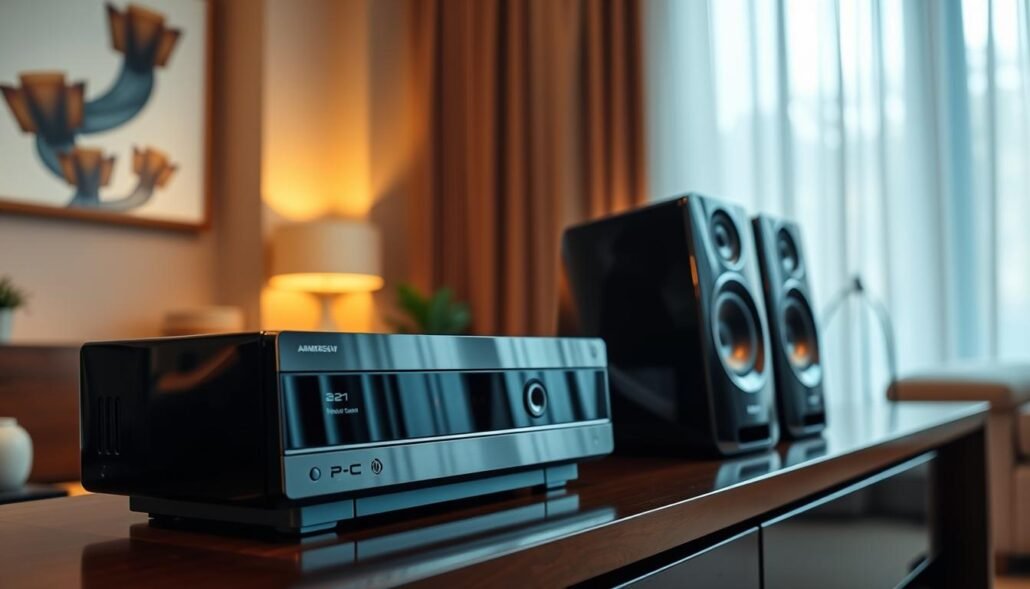What a receiver does: In a modern home theater, a receiver switches, decodes, and amplifies both audio and video signals from TVs, Blu‑ray players, consoles, and streamers.
That single box gives you a built‑in amp for better sound, simpler cable runs, multi‑format support, wireless options, and room correction to tune the listening space.
This short guide moves from quick start checks to specific fixes and then to advanced tips for lasting reliability. Expect step‑by‑step help for no power, no sound, missing channels, lip‑sync errors, HDMI video failures, protection mode, and overheating.
Many faults come from wrong input selection, loose wires, bad HDMI labeling, or outdated firmware—not failed hardware. Be safe: check wall outlets, power cycle correctly, and avoid hot‑plugging sensitive HDMI ports.
Keep a simple checklist of connections, input names, and speaker wiring to speed future fixes. For deeper diagnostics and calibration tips, see this related review of models and setup notes: best receivers for most people.
Start Here: av receiver troubleshooting guide for fast diagnostics
A few fast checks of outlets, inputs, and speaker wiring will resolve most system faults. Begin with simple tests before swapping gear or calling support. These steps save time and narrow down the cause.

Power and protection: outlet, breaker, and receiver power cycle
Test the wall outlet with a lamp or phone charger to confirm power. Reseat the IEC power cable and try a different outlet to rule out a bad strip or tripped breaker.
Power cycle properly: turn the unit off, unplug for 60 seconds, then plug back in. If the unit immediately shuts down, disconnect all speaker wires and reconnect them one at a time to find a shorted lead.
Source and input selection: HDMI, optical, and the correct input
Match the device to the labeled input and verify the on‑screen input name. Check HDMI and optical plugs are fully seated to avoid “no signal” confusion.
Swap the device to another HDMI port or use a different device to isolate whether the problem is with the source, the cable, or the receiver input.
Cable sanity check: HDMI, speaker wires, and interconnects
Inspect cables end‑to‑end for bent pins, cuts, or loose fits. Replace suspect HDMI cables and avoid tight bends behind the rack.
Tug‑test speaker wires at both ends. Fix stray copper strands so they do not short and trigger protection.
Baseline settings: speaker config, levels, and surround modes
Confirm speakers are enabled and assigned correctly. Set sizes, distances, and crossover to get accurate timing and bass.
Run test tones and set channel levels. Update firmware from the manufacturer menu to fix known issues before a factory reset.
Fix common home theater audio and video problems
Before swapping gear, run a short checklist to isolate whether the fault is with power, source, or speakers.
No power or intermittent shutdowns
Confirm a live outlet and reseat the IEC power cord. Try a different circuit and replace remote batteries if needed.
No audio or low volume from speakers
Check speaker wiring, polarity, and tightness. Verify speaker assignments, sizes, and crossover in the menu.
One or more channels not working
Run test tones or use an SPL meter. Swap a speaker to another output to isolate a bad speaker or amp channel.
Weak bass or subwoofer silence
Ensure the sub is powered and line-level cables are secure. Set speakers to Small at 80 Hz and raise the sub LPF.
- HDMI/video: replace suspect cables and confirm correct input selection.
- Protection mode: look for stray strands at binding posts and disconnect speakers one by one.
- Static or hum: re-seat interconnects and eliminate ground loops.
- Wireless issues: update firmware and re-pair Bluetooth devices.
Advanced fixes and optimization for your audio video system
Deep fixes often live in firmware updates, player output choices, and careful room tuning. Start with updates in the unit menu or via USB to resolve network, Bluetooth, and format bugs. Apply firmware before changing other settings.

Firmware, factory reset, and restoring defaults
Update firmware through the network or USB to fix stability and compatibility. If menus act erratically or odd bugs persist, perform a factory reset as a last resort.
Document current settings first so you can restore speaker sizes, crossover, and custom presets quickly.
Bitstream, multichannel formats, and player output
Set players to send multichannel bitstream over HDMI so the unit decodes Dolby and DTS formats. For legacy players without HDMI, use 5.1/7.1 analog outputs into the multichannel inputs.
Choose discrete Dolby/DTS modes for native multichannel and use matrix modes for stereo upmix when desired.
Room correction and crossover tuning
Start with all speakers set to Small and an 80 Hz crossover. Set the sub’s LPF to its highest point or off to avoid double filtering.
Treat auto‑EQ as a baseline: verify speaker size, crossover, and sub distance, then measure with an SPL app and tweak for smooth seat‑to‑seat bass.
- For setup reference, see this home theater setup article.
Conclusion
Conclude with a simple maintenance plan that preserves your home theater and reduces repeat issues. Keep a configuration table for each speaker’s size, level, distance, crossover, bass routing, and auto‑EQ status. Save and lock presets when possible to protect key settings.
When a problem resurfaces, recheck power, cables, and connection to the source before swapping parts. Verify speaker wiring and labels so one quick swap isolates faults fast.
If standard steps fail and the unit is under warranty, contact manufacturer support for service. Regularly clean vents, confirm airflow, and update firmware to keep the system reliable long term.